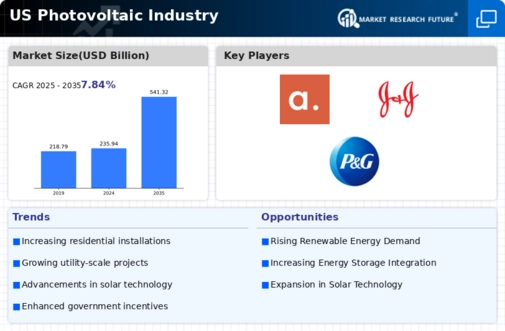The photovoltaic market exhibits a dynamic competitive landscape characterized by rapid technological advancements and a growing emphasis on sustainability. Key players such as First Solar (US), SunPower (US), and JinkoSolar (CN) are at the forefront, each adopting distinct strategies to enhance their market positioning. First Solar (US) focuses on innovation in thin-film technology, aiming to improve efficiency and reduce costs, while SunPower (US) emphasizes premium product offerings and customer-centric solutions. JinkoSolar (CN), on the other hand, leverages its extensive manufacturing capabilities to maintain competitive pricing, thereby appealing to a broader customer base. Collectively, these strategies contribute to a competitive environment that is increasingly shaped by technological prowess and customer engagement.
In terms of business tactics, companies are localizing manufacturing to mitigate supply chain disruptions and optimize logistics. This approach is particularly evident in the U.S. market, where firms are establishing production facilities closer to key markets. The competitive structure of the photovoltaic market appears moderately fragmented, with several players vying for market share. However, the influence of major companies like First Solar (US) and JinkoSolar (CN) remains substantial, as they set benchmarks for innovation and operational efficiency.
In October 2025, First Solar (US) announced a strategic partnership with a leading energy storage provider to enhance the integration of solar and storage solutions. This move is significant as it positions First Solar (US) to offer comprehensive energy solutions, catering to the increasing demand for reliable and sustainable energy sources. The partnership is likely to bolster First Solar's (US) market presence and reinforce its commitment to innovation in renewable energy.
In September 2025, SunPower (US) unveiled a new line of high-efficiency solar panels designed for residential use, featuring advanced AI technology for performance optimization. This launch underscores SunPower's (US) focus on leveraging technology to enhance product offerings, thereby appealing to environmentally conscious consumers seeking efficient energy solutions. The integration of AI into their products may provide a competitive edge in a market that increasingly values technological sophistication.
In August 2025, JinkoSolar (CN) expanded its manufacturing capacity in the U.S. by opening a new facility in Texas, aimed at meeting the growing domestic demand for solar products. This expansion not only reflects JinkoSolar's (CN) commitment to local production but also positions the company to better serve its U.S. customer base. The strategic move is likely to enhance JinkoSolar's (CN) competitiveness by reducing lead times and transportation costs, thereby improving overall supply chain efficiency.
As of November 2025, the photovoltaic market is increasingly defined by trends such as digitalization, sustainability, and the integration of AI technologies. Strategic alliances are becoming more prevalent, as companies recognize the value of collaboration in driving innovation and enhancing product offerings. Looking ahead, competitive differentiation is expected to evolve, shifting from price-based competition to a focus on technological innovation and supply chain reliability. This transition may redefine market dynamics, as companies that prioritize sustainability and advanced technology are likely to emerge as leaders in the photovoltaic landscape.













Leave a Comment